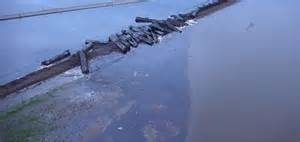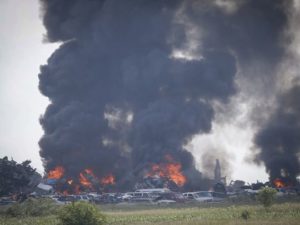32 Oil Tankers Spill 230,000 Gallons of Crude Oil into Rock River in Iowa : A Well Thought Out Scream by James Riordan

Just when you thought it was safe to go into the water. On Friday, a freight train derailed just south of Doon, Iowa, in the northwest part of the state. The area was already experiencing flood waters and around 4:30 in the morning thirty-two cars full of crude oil from Alberta, Canada left the track and dumped their load into the Rock River.
 No one was hurt in the derailment. Doon is a city of a few hundred people. The cause has not been confirmed, although Iowa Governor Kim Reynolds attributed it to an intense storm and flash flooding in an emergency proclamation issued by her office on Saturday. The spill threatened to contaminate drinking water for residents about 150 miles (240 km) downstream in Omaha, Nebraska.
No one was hurt in the derailment. Doon is a city of a few hundred people. The cause has not been confirmed, although Iowa Governor Kim Reynolds attributed it to an intense storm and flash flooding in an emergency proclamation issued by her office on Saturday. The spill threatened to contaminate drinking water for residents about 150 miles (240 km) downstream in Omaha, Nebraska.
Metropolitan Utilities District, which provides the Omaha metro area’s drinking water, said it was monitoring the spill. If needed, it would shift water pumping to two other water treatment plants, which are supplied by another river not connected to the spill, the utility said in a statement on Friday. The utility did not respond to a request on Sunday for an update on its monitoring.
A spokesman for the BNSF railroad, Andy Williams, said only fourteen of the tankers leaked into the flood swollen Little Rock River and that nearly half the spill, around a hundred thousand gallons, had been contained with booms near the derailment right and additional boom set up five miles downstream. Vacuum trucks and skimmers were being employed to remove the oil which crews would then separate from the water using additional equipment (It should be noted that the BNSF spokesman is a different Any Williams than the singer whose big hit Moon River would make the whole situation a bit ironic. It should also be noted that vocalist Andy Williams died back in 2012 which would have put a mystical, if not outright spiritual, spin on the situation which, in this writer’s opinion, would have far superseded the irony issue).
Williams added that, “In addition to focusing on the environmental recovery, ongoing monitoring is occurring for any potential conditions that could impact workers and the community and so far have found no levels of concern.” BNSF had hazardous materials and environmental experts on the scene and had begun cleanup within hours of the derailment, Williams said. “We are containing the oil that was spilled as close to the incident as possible using containment booms and recovering it with skimmers and vacuum trucks,” he said.
 A major part of the cleanup work includes building a temporary road parallel to the tracks to allow in cranes that can remove the derailed and partially-submerged oil cars. Williams said officials hoped to reach the cars Saturday. Lyon County Sheriff Steward Vander Stoep said between 30 and 40 semitrailers containing cleanup equipment had arrived at the scene near Doon, Iowa, by Friday afternoon.
A major part of the cleanup work includes building a temporary road parallel to the tracks to allow in cranes that can remove the derailed and partially-submerged oil cars. Williams said officials hoped to reach the cars Saturday. Lyon County Sheriff Steward Vander Stoep said between 30 and 40 semitrailers containing cleanup equipment had arrived at the scene near Doon, Iowa, by Friday afternoon.
The train was carrying tar sands oil from Alberta, Canada, to Stroud, Oklahoma, for ConocoPhillips. ConocoPhillips spokesman Daren Beaudo said each tanker can hold more than 25,000 gallons (20,817 imperial gallons) of oil. Beaudo said Saturday that the derailed oil cars were a model known as DOT117Rs, indicating they were newer or had been retrofitted to be safer and help prevent leaks in the event of an accident.
Rock Valley, Iowa, just southwest of the derailment, shut off its water wells within hours of the accident. It plans to drain and clean its wells and use a rural water system until testing shows its water is safe.
The derailment also caused concern downstream, including as far south as Omaha, Nebraska, about 150 miles (240 kilometers) from the derailment site. The spill reached the Rock River, which joins the Big Sioux River before merging into the Missouri River at Sioux City. Omaha’s public water utility — Metropolitan Utilities District — said it was monitoring pumps it uses to pull drinking water from the Missouri River.
As to the cause of the derailment, it is still under investigation but officials at the scene agreed that floodwaters played a part in causing the cars to leave the tracks, but said they weren’t yet sure whether the waters compromised the track, physically pushed the cars off it or played a part in some other way. The river rose rapidly Wednesday after 5 to 7 inches (13 to 18 centimetres) of rain fell Wednesday and a further downpour on Thursday.
Tank cars carrying crude oil are shown derailed about a mile south of Doon, Iowa, Friday, June 22, 2018. About 31 cars derailed after the tracks reportedly collapsed due to saturation from flood waters from adjacent Little Rock River.
A broadening sheen of oil spread near several of the tankers, which had piled up across the track and earthen berm, some submerged in the water. Vander Stoep said that drinking water in Doon and the immediate area didn’t seem to be in danger of contamination. But news of the spill was enough to prompt officials in Rock Valley, a small city about 5 miles (8.05 kilometres) southwest of the derailment, to shut off all the city’s drinking water wells. The water towers also will be drained as a precaution, said Rock Valley public information officer Travis Olson. In the meantime, the city is getting its water from the nearby Rock Valley Rural Water system, which Olson said is not in danger of being contaminated by the spill, The city, with a population of nearly 3,400, will stay on the rural water system until testing by the Iowa Department of Natural Resources confirms the safety of the city’s drinking water, Olson said. “I don’t know how long that will be,” he said. “It sounds like the cleanup is going to take a while.”
Williams said he was unsure how much oil leaked and how many of the cars were leaking. Lyon County Sheriff Vander Stoep said the oil was being carried downstream into the Rock River a few hundred yards west of the derailment. Vander Stoep said four homes near the site were evacuated. On top of the flooding and the oil spill, a large fire broke out at Post Metal Recycling, a scrap yard south of town. “Our city administrator said to me, ‘The only thing we need now is a plane crash,'” Rock Valley mayor Van Otterloo said. “Everything came at once.”
Members of the Rock Valley Fire Department responded to a large scrap metal fire at the Post Metal Recycling yard south of town on Friday, June 22, 2018.
The Rock River had already carried some oil to Rock Valley by midmorning, said Ken Hessenius with the Iowa Natural Resources Department. State crews were trying to determine how fast the oil was travelling south. The Rock River joins the Big Sioux River before merging into the Missouri River at Sioux City.
The task difficulty is compounded by the spreading floodwater, he said. “The river, instead of being 100 yards wide, is now maybe a half-mile wide” in spots, Hessenius said. “Our first major concerns are public water supplies,” he said, adding that several towns that draw water from shallow wells near the Rock River have been alerted about possible contamination.
Doon is about 40 miles (65 kilometres) southeast of Sioux Falls, South Dakota, where several rain-swollen rivers overflowed Thursday. The National Weather Service has forecast flooding in the area into the weekend.






No Comment